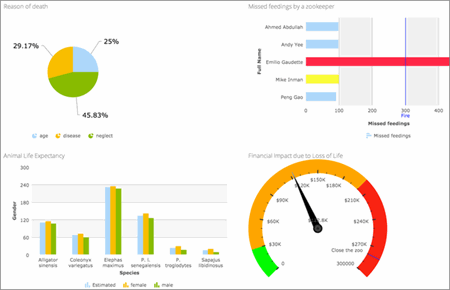Customize your report headers
Valid from Pega Version 7.1.5
You can customize the way that the header for all of an application's reports will be displayed by overriding the section pyReportEditorHeader. Save a copy of this section into the application's ruleset, then edit it to display the information, images, and layout that you desire. Once changes are saved, each of your application's reports will automatically use the updated header.
Advanced inline report filters
Valid from Pega Version 7.1.5
You can create a custom section and use it to display report filter controls at the top of the report, replacing the default display. The custom section can include basic controls (such as a drop-down menu or text entry field), and the controls can only provide values for the filter functions established in the Edit filters section of the Query tab for the Report Definition.
Use "alternate database" as report source
Valid from Pega Version 7.1.6
You can opt to use the the "alternate database" identified in the Reports Database field of the Data-Admin-DB-Table instance that supports the Applies To class of a report as the source for the report. This reduces the load on the database that serves your application when you run the report.
Report Viewer provides simplified user experience
Valid from Pega Version 7.1.7
In the Report Viewer, improvements simplify the user experience when working with reports. Column headers display initial sort order and type, and you can hover over a column header to display and use its context menu, which includes options for ad-hoc sorting and filtering. Developers can specify various pagination modes and set an option to keep the header in view while users scroll through the report.
For more information, see Report Viewer.
Enhanced BIX file naming
Valid from Pega Version 7.1.7
To help clarify file names, BIX extract output files and manifest files can now contain parameters. Parameters can include the rule name, the extract's run time and date, and a unique run sequence number. Special characters such as spaces, hyphens, or number signs (#) in the output or manifest file name are converted to underscores. In addition, the pxExtractIdentifier and pxExtractDateTime columns have been added to the .csv output file.
For more information, see Extracting data with BIX and Extract rules - completing the File Specification tab.
Enhanced chart control improves displaying data as a chart
Valid from Pega Version 7.1.7
The renewed chart control has an improved properties panel and provides HTML5-compliant pie, column, bar, area, line, and gauge charts. The chart source can be a report definition, a clipboard page, or a data page. You can customize basic and threshold colors, borders, line widths, labels, and other chart elements. A preview on the property panel instantly displays the effects on the chart of property changes you make.
For more information, see Harness and section forms - Adding a chart.

HTML5-compliant chart types
New property pxCommitDateTime
Valid from Pega Version 7.1.8
A new property, pxCommitDateTime, records the time when a record or updated rule was committed to the database. This property also allows for incremental extracts when running BIX.
Report Browser removed from Designer Studio
Valid from Pega Version 7.1.9
The Report Browser and Access landing page have been removed from Designer Studio. In Designer Studio, developers can create, edit, and test reports by using the Report Definition rule form.
The Report Browser is still available in the Case Manager portal.
Descendant class instances now included in reports
Valid from Pega Version 7.2
The Report on descendant class instances option on the Data Access tab of the Report Definition rule has a new option to now include data from all descendant classes of the report's primary class. If descendant classes are mapped to multiple class tables, the generated SQL query performs UNIONs to include this data. Previously, only a single class was included in the report.
You can select a subset of descendant classes to include or exclude by adding a filter condition on pxObjClass.
Existing reports retain the older behavior for this option after an upgrade or update. To use the new option, you must set it for each existing report. New reports created in Designer Studio and out-of-the-box Pega 7 Platform template reports from which new reports are created in the Report Browser (pyDefaultReport and pyDefaultSummaryReport) default to the new option. If you have created custom template reports for some application classes, you must change them to enable the new option in reports that are created in the Report Browser for these classes.
See Reporting on data in multiple class tables.
Report Definition query filters can search embedded properties
Valid from Pega Version 7.2
Filter conditions on Report Definition rules that query the Elasticsearch indexes can now reference embedded properties. Previously, filter conditions could reference only the top-level properties of a class. To reference an embedded property within a filter condition, specify indexes for embedded page lists and page groups, for example, Customers(1).Addresses(1).City = Boston OR Customers(1).Addresses(1).State = MA.
These indexes are ignored in the generated query, and so can potentially match any value in a page list or group. However, filter conditions that reference multiple embedded properties in the same page list or page group, as displayed above, might not be satisfied on the same page.

